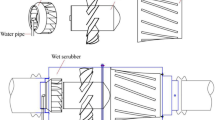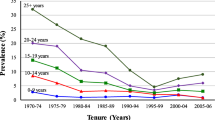Abstract
Controlling dust generation and keeping it below permissible limits to meet federal dust standards at the working face of a room-and-pillar coal mine is a challenge for a mine operator. With the recent changes in federal dust regulations requiring lower worker exposure, maintaining compliance has become increasingly difficult. The current most effective practice of dust control at a continuous miner face in an underground mine is the use of a flooded-bed scrubber. A study carried out by the National Institute for Occupational Safety and Health (NIOSH) indicated that a flooded-bed scrubber could achieve cleaning efficiencies between 58 and 90%. But, the operation of such a system is maintenance intensive. The flooded-bed scrubber screen becomes clogged with dust particles and requires frequent cleaning to maintain performance. However, the dust control issue is not solely a mining industry problem. Other industries face similar issues. The University of Kentucky collaborated with Toyota Motor Manufacturing on the development of a novel wet scrubber, called the vortecone scrubber, for capturing oversprayed paint particles in automotive paint booths. The vortecone scrubber achieved a cleaning efficiency of 99% and required minimal maintenance. This study aims to assess the ability of this vortecone scrubber to capture respirable dust in an underground coal mine. The paper presents the results of computational fluid dynamics (CFD) modeling of this vortecone scrubber. It discusses the effects of air quantity and dust particle size on the performance of the scrubber.













Similar content being viewed by others
References
U.S. Department of Labor (2014) Lowering miners’ exposure to respirable coal mine dust, including continuous personal dust monitors. In: Fed Regist Vol 79, Number 84. http://arlweb.msha.gov/regs/fedreg/final/2014finl/2014-09084.asp. Accessed 1 May 2014
Sinclair J (1958) Environmental conditions in coal mines: including fires, explosions, rescue and recovery work. Pitman
NIOSH (2008) Work-related lung disease surveillance report 2007, Volume 1. Dep Heal Hum Serv Centers Dis Control Prev Natl Inst Occup Saf Heal Div Respir Dis Stud DHHS
Cashdollar KL, Sapko MJ (2006) Explosion hazards of coal dust in the presence of methane. In: Handbook for methane control in mining, pp 147–150
U.S. Department of Labor (2001) Report of investigation, fatal underground coal mine explosions, September 23, 2001, No. 5 Mine, Jim Walter Resources, Brookwood, Tuscaloosa County, Alabama, ID No. 01–01322
U.S. Department of Labor (2011) Report of investigation, fatal underground mine explosion, April 5, 2010, Upper Big Branch Mine-South, Performance Coal Company, Montcoal, Raleigh County, West Virginia, ID No. 46–08436
U.S. Department of Labour (2009) End Black Lung - ACT NOW. http://arlweb.msha.gov/S&HINFO/BlackLung/homepage2009.asp. Accessed 11 Oct 2016
U.S. Department of Labor (2010) Lowering miners’ exposure to respirable coal mine dust, including continuous personal dust monitors, proposed rule. In: 30 CFR Parts 70, 71, 72, al. http://arlweb.msha.gov/REGS/FEDREG/PROPOSED/2010PROP/2010-25249.PDF. Accessed 11 Oct 2016
U.S. Department of Labor (2014) Final rule. http://arlweb.msha.gov/regs/fedreg/final/2014finl/2014-09084.asp. Accessed 26 August 2015
Wang W, Peng FF (1991) Analyses of respirable dust distributions with multiple dust sources on longwall faces. In: Proceedings of Society for Mining, Metallurgy & Exploration. pp 367–375
Colinet JF, Spencer ER, Jankowski RA (1997) Status of dust control technology on U.S. longwalls. In: Proceedings of 6th International Mine Ventilation Congress. pp 345–351
Arya S, Sottile J, Novak T (2018) Development of a flooded-bed scrubber for removing coal dust at a longwall mining section. Saf Sci 110:204–213. https://doi.org/10.1016/j.ssci.2018.08.003
Arya S, Sottile J, Rider JP, Colinet JF, Novak T, Wedding C (2018) Design and experimental evaluation of a flooded-bed dust scrubber integrated into a longwall shearer. Powder Technol 339:487–496. https://doi.org/10.1016/j.powtec.2018.07.072
Arya S, Novak T, Saito K et al (2019) Empirical formulae for determining pressure drop across a 20-layer flooded-bed scrubber screen. Min Metall Explor. https://doi.org/10.1007/s42461-019-0091-5
Arya S (2018) Investigation of the effectiveness of an integrated flooded-bed dust scrubber on a longwall shearer through laboratory testing and CFD simulation. University of Kentucky
Campbell JAL, Moynihan DJ, Roper WD, Willis C (1983) Dust control system and method of operation
Wedding WC, Novak T, Arya S, Kumar A (2015) CFD modeling of a flooded-bed scrubber concept for a longwall shearer operating in a U.S. Coal Seam. In: Proceedings of 15th US Mine Ventilation Symposium. pp 385–390
Wirch S, Jankowski R (1991) Shearer-mounted scrubbers, are they viable and cost effective. In: Proceedings of 7th US Mine Ventilation Symposium. pp 319–325
NIOSH (1997) Hazard identification 1: exposure to silica dust on continuous mining operations using flooded-bed scrubbers. U.S. Department of Health and Human Services, Public Health Service, Centers for Disease Control and Prevention, National Institute for Occupational Safety and Health, DHHS (NIOSH)
Colinet JF, Reed WR, Potts JD (2014) Continuous mining dust levels in 20-foot cuts with and without a scrubber operating. In: Proceedings of Society for Mining, Metallurgy & Exploration. Salt Lake City, UT, p Preprint 14–033
Colinet JF, Reed WR, Potts JD (2013) Impact on respirable dust levels when operating a flooded-bed scrubber in 20-foot cuts. In: U.S. Department of Health and Human Services, Public Health Service, Centers for Disease Control and Prevention, National Institute for Occupational Safety and Health, DHHS (NIOSH) Publication No. 2014-105, RI 9693. Pittsburgh\
Potts JD, Reed WR, Colinet JF (2011) Evaluation of face dust concentrations at mines using deep-cutting practices. In: U.S. Department of Health and Human Services, National Institute for Occupational Safety and Health, DHHS (NIOSH) Publication No. 2011-131, RI 9680. Pittsburgh
Salazar AJ, Saito K, Alloo RP, Tanaka N (2000) Wet scrubber and paint spray booth including the wet scrubber
Saito K (2008) Progress in Scale Modeling: Summary of the First International Symposium on Scale Modeling (ISSM I in 1988) and Selected Papers from Subsequent Symposia (ISSM II in 1997 through ISSM V in 2006). Springer Netherlands
Li T, Salarzar AJ, Saito K (2009) Experimental and numerical feasibility study of modifying automotive wet scrubber for capturing particulate in coal-fired power plants. In: Proceedings of 6th International Symposium on Scale Modeling. Kauai, Hawaii, pp 1–10
Kurnia JC, Sasmito AP, Mujumdar AS (2014) Dust dispersion and management in underground mining faces. Int J Min Sci Technol 24:39–44. https://doi.org/10.1016/J.IJMST.2013.12.007
Yueze L, Akhtar S, Sasmito AP, Kurnia JC (2017) Prediction of air flow, methane, and coal dust dispersion in a room and pillar mining face. Int J Min Sci Technol 27:657–662. https://doi.org/10.1016/J.IJMST.2017.05.019
Geng F, Luo G, Wang Y, Peng Z, Hu S, Zhang T, Chai H (2018) Dust dispersion in a coal roadway driven by a hybrid ventilation system: a numerical study. Process Saf Environ Prot 113:388–400. https://doi.org/10.1016/J.PSEP.2017.11.010
Gilmore RC, Marts JA, Brune JF et al (2015) Simplifying CFD modeling of longwall gobs with modular meshing approach. Min Eng 67:2015
Hu S, Feng G, Ren X, Xu G, Chang P, Wang Z, Zhang Y, Li Z, Gao Q (2016) Numerical study of gas–solid two-phase flow in a coal roadway after blasting. Adv Powder Technol 27:1607–1617. https://doi.org/10.1016/J.APT.2016.05.024
Lolon SA, Brune JF, Bogin GE et al (2017) Computational fluid dynamics simulation on the longwall gob breathing. Int J Min Sci Technol 27:185–189. https://doi.org/10.1016/J.IJMST.2017.01.025
Wang Z, Ren T, Ma L, Zhang J (2018) Investigations of ventilation airflow characteristics on a longwall face—a computational approach. Energies 11
Zhou G, Zhang Q, Bai R, Fan T, Wang G (2017) The diffusion behavior law of respirable dust at fully mechanized caving face in coal mine: CFD numerical simulation and engineering application. Process Saf Environ Prot 106:117–128. https://doi.org/10.1016/J.PSEP.2016.12.005
Fig MK, Bogin GE, Brune JF, Grubb JW (2016) Experimental and numerical investigation of methane ignition and flame propagation in cylindrical tubes ranging from 5 to 71 cm – part I: effects of scaling from laboratory to large-scale field studies. J Loss Prev Process Ind 41:241–251. https://doi.org/10.1016/j.jlp.2016.03.018
Ajayi K, Shahbazi K, Tukkaraja P, Katzenstein K (2019) Numerical investigation of the effectiveness of radon control measures in cave mines. Int J Min Sci Technol 29:469–475. https://doi.org/10.1016/J.IJMST.2018.07.006
Software Cradle Co. Ltd. (2015) User’s Guide Basics of CFD Analysis
Ramani R V, Mutmansky JM, Bhaskar R, Qin J (1987) Fundamental studies on the relationship between quartz levels in the host material and the respirable dust generated during mining, volume 1: experiments, results and analysis. Washington, DC
Funding
The funding for this research was provided by the National Institute for Occupational Safety and Health (NIOSH) (grant number 200-2014-59922).
Author information
Authors and Affiliations
Corresponding author
Ethics declarations
Conflict of Interest
The authors declare that they have no conflict of interest.
Additional information
Publisher’s Note
Springer Nature remains neutral with regard to jurisdictional claims in published maps and institutional affiliations.
Rights and permissions
About this article
Cite this article
Arya, S., Novak, T. Numerical Investigation of the Effect of a Novel Wet Scrubber on Dust Reduction in an Underground Coal Mine. Mining, Metallurgy & Exploration 37, 129–139 (2020). https://doi.org/10.1007/s42461-019-00135-2
Received:
Accepted:
Published:
Issue Date:
DOI: https://doi.org/10.1007/s42461-019-00135-2




